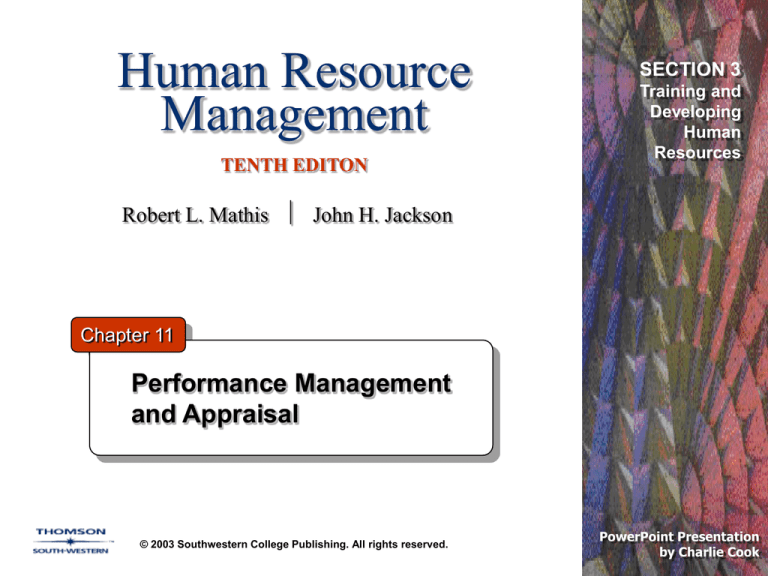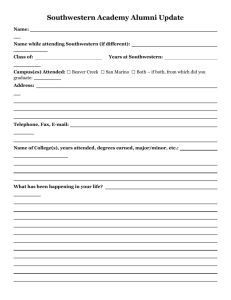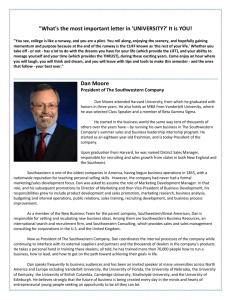
Human Resource
Management
TENTH EDITON
SECTION 3
Training and
Developing
Human
Resources
Robert L. Mathis John H. Jackson
Chapter 11
Performance Management
and Appraisal
© 2003 Southwestern College Publishing. All rights reserved.
PowerPoint Presentation
by Charlie Cook
Learning Objectives
After you have read this chapter, you should be
able to:
– Distinguish between job criteria and performance
standards and discuss criterion contamination and
deficiency.
– Identify two major uses of performance appraisal.
– Provide examples of several rater errors.
– Describe both the advantages and disadvantages of
multisource (360°) appraisal.
© 2002 Southwestern College Publishing. All rights reserved.
11–2
Learning Objectives (cont’d)
– Identify the nature of behavioral approaches to
performance appraisal and management by
objectives (MBO).
– Discuss several concerns about appraisal feedback
interviews.
– Identify the characteristics of a legal and effective
performance appraisal system.
© 2002 Southwestern College Publishing. All rights reserved.
11–3
Identifying and Measuring
Employee Performance
Performance Management System
– Processes used to identify, encourage, measure,
evaluate, improve, and reward employee
performance.
Performance
– What an employee does and does not do.
• Quantity of output
• Timeliness of output
• Cooperativeness
• Quality of output
• Presence at work
Job Criteria
– Important elements in a given job
© 2002 Southwestern College Publishing. All rights reserved.
11–4
Linkage
Between
Strategy,
Outcomes,
and
Organizational
Results
Figure 11–1
© 2002 Southwestern College Publishing. All rights reserved.
11–5
Types of Performance Information
Trait-based
Information
Job
Performance?
Behavior-based
Information
Results-based
Information
© 2002 Southwestern College Publishing. All rights reserved.
11–6
Potential Performance Criteria Problems
Deficiency
Contamination
Performance
Criteria
Objectivity
© 2002 Southwestern College Publishing. All rights reserved.
11–7
Performance Standards
Performance Standards
– Expected levels of performance
• Benchmarks
• Goals
• Targets
Characteristics of Well-defined Standards
– Realistic
– Measurable
– Clearly understood
© 2002 Southwestern College Publishing. All rights reserved.
11–8
Terms Defining Standards on One Company
Figure 11–2
© 2002 Southwestern College Publishing. All rights reserved.
11–9
Uses of Performance Appraisal
Performance Appraisal (PA)
– The process of evaluating how well employees
perform their jobs when compared to a set of
standards, and then communicating the information
to employees.
– Informal Appraisal
• Day-to-day contacts, largely undocumented
– Systematic Appraisal
• Formal contact at regular time intervals, usually
documented
© 2002 Southwestern College Publishing. All rights reserved.
11–10
Uses of Performance Appraisal (cont’d)
Performance
Appraisal
Administering Wages
and Salaries
Giving Performance
Feedback
© 2002 Southwestern College Publishing. All rights reserved.
Identifying Strengths
and Weaknesses
11–11
Uses of Performance Appraisal (cont’d)
Criticisms of Performance Appraisal
– Focus is too much on the individual and does little
to develop employees.
– Employees and supervisors believe the appraisal
process is seriously flawed.
– Appraisals are inconsistent, short-term oriented,
subjective, and useful only at the extremes of
performance.
© 2002 Southwestern College Publishing. All rights reserved.
11–12
Conflicting Roles for Performance Appraisal
Figure 11–3
© 2002 Southwestern College Publishing. All rights reserved.
11–13
Typical Division of HR Responsibilities
for Performance Appraisal
Figure 11–4
© 2002 Southwestern College Publishing. All rights reserved.
11–14
Who Conducts Appraisals
Supervisors who rate their subordinates
Employees who rate their supervisors
Team members who rate each other
Outside sources
Employees’ self-appraisal
Multisource (360° feedback) appraisal
© 2002 Southwestern College Publishing. All rights reserved.
11–15
Traditional Performance
Appraisal:
Logic and Process
Figure 11–5
© 2002 Southwestern College Publishing. All rights reserved.
11–16
Employee Rating of Managers
Advantages
– Helps in identifying
competent managers
– Serves to make managers
more responsive to
employees
– Can contribute to the
career development of
managers
© 2002 Southwestern College Publishing. All rights reserved.
Disadvantages
– Negative reactions by
managers to employee
ratings
– Subordinates’ fear of
reprisals may inhibit them
from giving realistic
(negative) ratings
– Ratings are useful only for
self-improvement purposes
11–17
Team/Peer Ratings
Advantages
– Helps improve the
performance of lowerrated individuals
– Peers have opportunity to
observe other peers.
– Peer appraisals focus on
individual contributions to
teamwork and team
performance.
© 2002 Southwestern College Publishing. All rights reserved.
Disadvantages
– Can negatively affect
working relationships.
– Can create difficulties for
managers in determining
individual performance.
– Organizational use of
individual performance
appraisals can hinder the
development of teamwork
11–18
Multisource Appraisal
Figure 11–6
© 2002 Southwestern College Publishing. All rights reserved.
11–19
Performance Appraisal Methods
Figure 11–7
© 2002 Southwestern College Publishing. All rights reserved.
11–20
Category Rating Methods
Graphic Rating Scale
– A scale that allows the rater to indicate an
employee’s performance on a continuum.
• Job criteria scales
• Behavioral scales
– Drawbacks
• Restrictions on the range of possible rater responses
• Differences in the interpretations of the meanings of
scale items and scale ranges by raters
• Poorly designed scales that encourage rater errors
• Rating form deficiencies that limit the effectiveness of
the appraisal
© 2002 Southwestern College Publishing. All rights reserved.
11–21
Category Rating Methods (cont’d)
Checklists
– A performance appraisal tool that uses a list of
statements or work behaviors that are checked by
raters.
• Can be quantified by applying weights to individual
checklist items.
– Drawbacks
• Interpretation of item meanings by raters
• Weighting creates problems in appraisal interpretation
• Assignment of weights to items by persons other than
the raters
© 2002 Southwestern College Publishing. All rights reserved.
11–22
Sample Performance Appraisal Form
Figure 11–8a
© 2002 Southwestern College Publishing. All rights reserved.
11–23
Sample Performance Appraisal Form
Figure 11–8b
© 2002 Southwestern College Publishing. All rights reserved.
11–24
Comparative Methods
Ranking
– Listing of all employees from highest to lowest in
performance.
– Drawback
• Does not show size of differences in performance
between employees
• Implies that lowest-ranked employees are
unsatisfactory performers.
• Becomes an unwieldy process if the group to be
ranked is large.
© 2002 Southwestern College Publishing. All rights reserved.
11–25
Comparative Methods (cont’d)
Forced Distribution
– Performance appraisal method in which ratings of
employees are distributed along a bell-shaped
curve.
– Drawbacks
• Assumes a normal distribution of performance.
• Resistance by managers to placing individuals in the
lowest or highest groups.
• Providing explanation for placement in a higher or
lower grouping can be difficult.
• Is not readily applicable to small groups of employees.
© 2002 Southwestern College Publishing. All rights reserved.
11–26
Forced Distribution on a Bell-Shaped Curve
Figure 11–9
© 2002 Southwestern College Publishing. All rights reserved.
11–27
Narrative Methods
Critical Incident
– Manager keeps a written record of highly favorable
and unfavorable employee actions.
– Drawbacks
• Variations in how managers define a “critical incident”
• Time involved in documenting employee actions
• Most employee actions are not observed and may
become different if observed
• Employee concerns about manager’s “black books”
© 2002 Southwestern College Publishing. All rights reserved.
11–28
Narrative Methods (cont’d)
Essay Method
– Manager writes a short essay describing an
employee’s performance.
– Drawbacks
• Depends on the managers’ writing skills and their
ability to express themselves.
Field Review
– Outside reviewer interviews the manager about the
performance of each employee and develops a
rating for the employees from the interview notes.
© 2002 Southwestern College Publishing. All rights reserved.
11–29
Behavioral/Objective Methods
Behavioral Rating Approach
– Assesses employees’ behaviors instead of other
characteristics
– Consists of a series of scales created by:
• Identifying important job dimensions
• Creating statements describing a range of desired and
undesirable behaviors (anchors)
– Types of behavioral scales
• Behaviorally anchored rating scales (BARS)
• Behavioral observation scales (BOS)
• Behavioral expectation scales (BES)
© 2002 Southwestern College Publishing. All rights reserved.
11–30
Customer Service Skills (BOS)
Figure 11–10
© 2002 Southwestern College Publishing. All rights reserved.
11–31
Management by Objectives
Management by Objectives
– Specifying the performance goals that an individual
and his or her manager agree to try to attain within
an appropriate length of time.
Key MBO Ideas
– Employee involvement creates higher levels of
commitment and performance.
– Encourages employees to work effectively toward
achieving desired results.
– Performance measures should be measurable and
should define results.
© 2002 Southwestern College Publishing. All rights reserved.
11–32
The MBO Process
Job Review and Agreement
Development of Performance Standards
Guided Objective Setting
Continuing Performance Discussions
© 2002 Southwestern College Publishing. All rights reserved.
11–33
Common Rater Errors
Figure 11–11
© 2002 Southwestern College Publishing. All rights reserved.
11–34
Feedback as a System
Evaluation
of Data
Data
Feedback
System
Action Based on
Evaluation
© 2002 Southwestern College Publishing. All rights reserved.
11–35
Appraisal Interview Hints
Figure 11–12
© 2002 Southwestern College Publishing. All rights reserved.
11–36
Performance Appraisals and the Law
Legally Defensible PA System
– Appraisal criteria based on job analysis
– Absence of disparate impact and evidence of validity
– Formal evaluation criterion that limit managerial
discretion
– Formal rating instrument linked to job duties and
responsibilities
– Personal knowledge of and contact with ratee
– Training of supervisors in conducting appraisals
– Review process to prevent undue control of careers
– Counseling to help poor performers improve
© 2002 Southwestern College Publishing. All rights reserved.
11–37
Performance Management System
Effective PMS systems are:
– Consistent with the strategic mission of the
organization
– Beneficial as development tool
– Useful as an administrative tool
– Legal and job-related
– Viewed as generally fair by employees
– Effective in documenting employee performance
© 2002 Southwestern College Publishing. All rights reserved.
11–38



